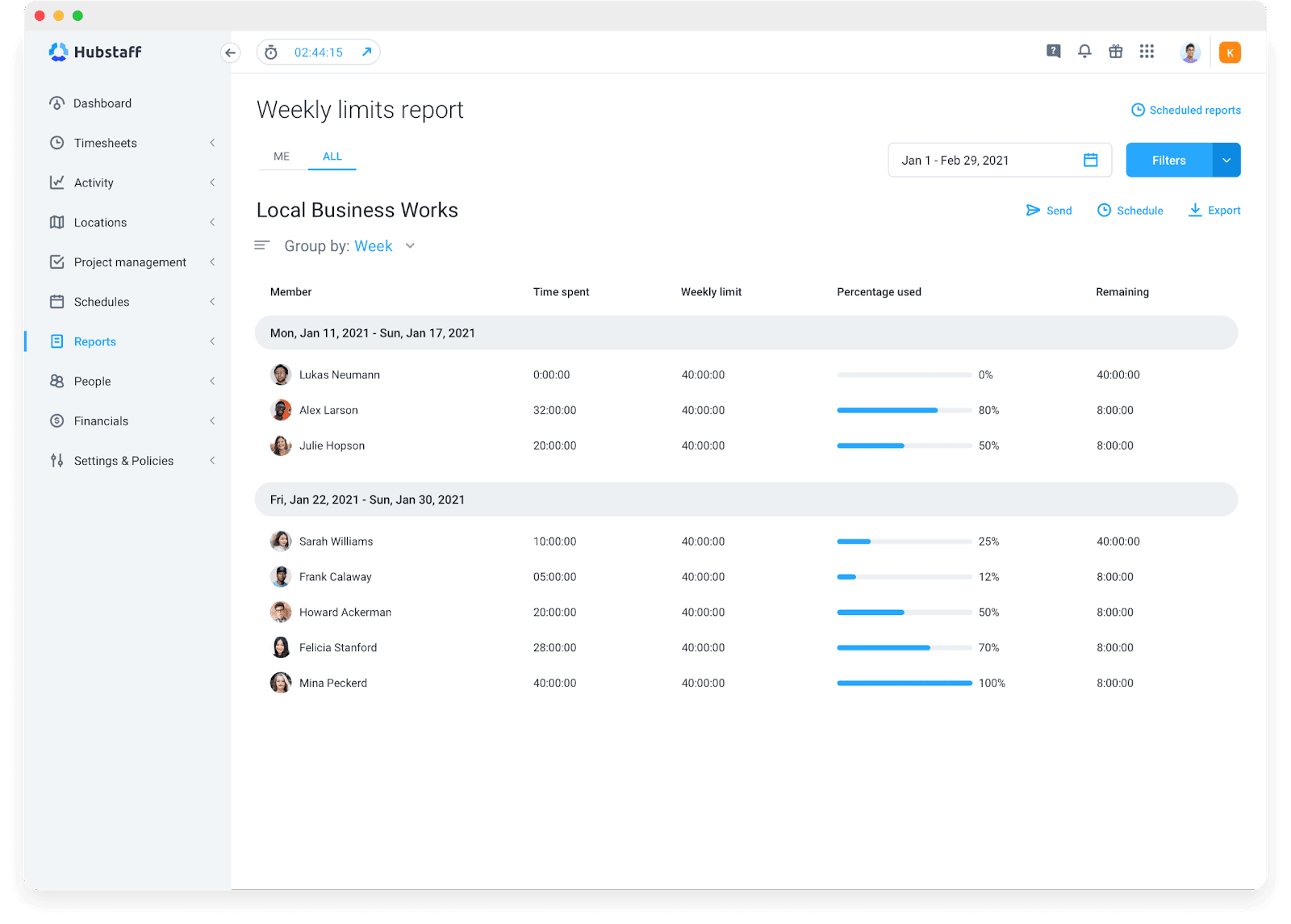For most companies and their remote teams, time tracking is a means for them to keep accurate timesheets — but that doesn’t mean it’s seamless. That’s why we’ve put together some time tracking best practices for remote workers.
On their own, time management techniques can save you a lot of time. When you add time tracking best practices into the mix, you can kick up your productivity another notch, allowing you to easily stay on top of all your tasks and make the most of your day.
In this article, we’ll explore 15 time tracking best practices to help you optimize your time and productivity.
Let’s get started.
Boost your team’s efficiency with Hubstaff's productivity tools
1. Set clear goals
Before you start tracking your time, you need to clearly identify what you want to achieve. Time tracking tools are excellent for reaching targeted goals, but they aren’t magical devices that tell you whether you’re doing well immediately.
Start by setting SMART (Specific, Measurable, Attainable, Relevant, and Time-Bound) to keep your team focused. Eventually, you can challenge yourself and set bigger goals for longer time periods. It’s okay to begin with small goals as long as you complete them 100%.
2. Use a reliable time tracking app
There are plenty of time tracking apps available for remote workers, but the reality is that some are better than others. This is why it’s important to define your goals before you decide on a time tracker. Each person will have different needs and will thus find some time trackers more suitable than others.
For example, suppose you only want to track how much time you spend working over a specific time. A basic time tracker (or even your phone’s stopwatch) will likely suffice.
On the flip side, if you want to pinpoint time-wasting apps or gauge activity, you’ll be better off with a more comprehensive time tracking solution like Hubstaff.
Don’t be afraid to research and try different options. The long-term effects of a strong time tracking tool make the search worth the effort. Find one that works for you and use it consistently to track your time and measure your progress.
3. Break down your tasks
There’s a reason divide-and-conquer is such a timeless and endearing strategy: it works in virtually any aspect of life. If you have a large, intimidating project right before you, try some productivity methods to break it down into smaller chunks.
The main benefit is that everything becomes significantly more manageable. You’ll also eliminate the fear and indecisiveness that comes with facing a massive task. It’s easier to stay focused when you have small victories. Otherwise, worrying about how much more work you need to do to complete the task as a whole can be stressful.
4. Schedule breaks
Remote work or not, taking breaks seems to be a lot harder than it should be. Even we folks at Hubstaff succumb to this phenomenon every so often. However, that’s why work breaks exist. Taking short, frequent breaks can help you stay engaged and productive.
Mental health is just as important as physical health, too. Take short breaks to meditate or engage in other relaxation activities to maintain your mental well-being.
Some time tracking tools have built-in work break features so you can seamlessly integrate breaks into your normal workflow. Take advantage of this and give your mind ample rest throughout the workday.
5. Learn to prioritize effectively
Being productive isn’t always about completing as many tasks as you can over a period of time. More often than not, focusing on these types of quantitative metrics leads to productivity theater. If you finished five tasks in a day but missed one that three other teams were waiting on, you’d hardly call it successful.
Not all tasks are created equal. Identify the most important tasks and tackle them first to ensure you’re making progress on the most critical items. That said, task prioritization is a skill in and of itself, but one that’s worth learning. Tracking time is a great way to know if you’re spending time on the right tasks.
6. Set work limits
Knowing when it’s time to stop working is one of the best practices for time tracking that you can ever learn. Nobody is superhuman in the comic book sense (if you are, please reach out). Even when you enjoy your work, burnout will eventually catch up to you.

Identify and respect your limits. The best way to keep working in peak conditions is to stop working when you’ve overexerted yourself. If you’re a manager, it’s important to try and spot these signs of burnout.
Tools like Hubstaff help businesses protect work-life balance with built-in work limits. Once users start to learn their peak hours, you can set a maximum hourly or daily number of hours you can work, start tracking, and get to work. It’s also a great way for managers to avoid racking up overtime costs.
7. Review your progress regularly
As you track time to various tasks and projects, you’ll better understand how you utilize your time and handle specific types of work. You might not think about it a lot, but the power of retrospect is one of the strongest benefits time tracking can provide. Hindsight is 20/20, as they say.
Periodically review your time tracking data to identify patterns and areas for improvement. Maybe you’re spending too much time sitting in meetings or replying to emails. Time tracking metrics will give you detailed information on your time usage, which you can use to adjust your strategies and optimize your productivity.
8. Set realistic deadlines
Buzzer beaters are cool if you’re into sports, but it’s not cool when you’re perpetually beating deadlines by a hair. You may not be jeopardizing your team’s workflows by doing so, but constantly working with a “Will I make it this time?” approach doesn’t help your mental health.
Unrealistic deadlines can lead to stress and burnout. Set realistic deadlines for each task to ensure you’re giving yourself enough time. If you think a task will take at least a day to complete, set the deadline the day after. Under promise, over deliver. There’s no shame in going easy on yourself.
9. Minimize distractions
We all know distractions are one of the biggest killers of productivity. With time tracking, you can identify common distractions and minimize them. This might include:
- Turning off notifications
- Closing unnecessary tabs
- Identifying time-wasting websites and apps
- Limiting email checking
Many time tracking apps have activity-tracking features, so you can quickly jump into your activity data and pinpoint non-work apps that consume too much of your time.
10. Try the Pomodoro technique
With so many time management techniques, it’s understandable when people become indecisive. To address this, try the Pomodoro technique.
The Pomodoro technique is designed to help you consistently get work done. It follows a basic structure:
- Work on a task for 25 minutes.
- Take a break for five minutes.
- After four rounds of working, take a longer 30-minute break.
- Repeat until you’ve finished all your to-dos for the day.
Practicing the Pomodoro technique with a time tracker is straightforward. Track time to a task for 25 minutes, then rest for five minutes. Rinse and repeat. You can even create a task specifically for your breaks to stay accurate.
11. Communicate with your team
Communication is key when it comes to remote work. Keep your team informed about your progress and create a culture where you let each other know if you face any challenges.
This doesn’t always mean sending them a message whenever you encounter a bump in the road. For instance, if you spent more time on a task than initially planned, you can leave a note in your time entries explaining why. This allows your teammates to adjust properly instead of operating using guesswork.
Collaborating in project management tools is another way of communicating, too. Keep your teammates in the loop through timely messages so everyone can work harmoniously.
12. Plan the following day at the end of your shift
Prepare for the next day by planning your tasks and priorities the night before. This way, you can hit the ground running and avoid wasting time figuring out what to do next.

You can quickly set this up in a time tracker, too. Create the tasks you need in the app, and you’ll be reminded the next time you sign in. It’s best to do this as you’re wrapping up your work day. You’ll still have some momentum, and it allows you to jump right in the next day.
13. Get feedback from others
With a good time tracking app, you’ll get access to more than just time entries. You can also view more advanced performance metrics like activity scores and focus time.
Share these with your peers or managers and ask them to help you identify blind spots and areas for improvement. Use this feedback to adjust your strategies and boost your productivity.
However, that’s only half of the equation. Metrics are valuable, but work output should ultimately be your priority. Basing your feedback purely on metrics is much closer to micromanagement than you think.
14. Keep a calendar
Use a calendar to keep track of important deadlines, meetings, and events. This way, you can stay organized and avoid missing important tasks.
A calendar gives you a big picture of overarching projects or long-term goals. On the other hand, time tracking helps you efficiently work through them as smaller tasks. Together, they can help you stay organized regardless of how many things you have on your plate.
15. Give yourself grace
Remote work can be challenging, so being kind to yourself and others is important. Recognize that it’s okay for you and your team to face setbacks and challenges. You won’t be doing anyone any favors by being too hard on yourself and others.
Understandably, when tracking time, you might blame yourself when you worked more (or fewer) hours than you had originally wanted. Or maybe you’re new to remote work and haven’t yet figured out the best way to collaborate with your teammates.
That’s okay. Things don’t always go according to plan, so think of each new day as an opportunity for growth.
Conclusion
Time tracking can be a powerful tool for remote workers, but it’s important to use effective time tracking best practices to make the most of your productivity.
With these best practices in mind, it won’t be long before you become a master at time management and an exceptional remote worker or remote team lead. Whether you’re a solo getting a start-up off the ground or a team lead at an enterprise, these time tracking habits can help you reach new heights.
Most popular
The Fundamentals of Employee Goal Setting
Employee goal setting is crucial for reaching broader business goals, but a lot of us struggle to know where to start. American...
Data-Driven Productivity with Hubstaff Insights: Webinar Recap
In our recent webinar, the product team provided a deep overview of the Hubstaff Insights add-on, a powerful productivity measurem...
The Critical Role of Employee Monitoring and Workplace Security
Why do we need employee monitoring and workplace security? Companies had to adapt fast when the world shifted to remote work...
15 Ways to Use AI in the Workforce
Whether through AI-powered project management, strategic planning, or simply automating simple admin work, we’ve seen a dramatic...




